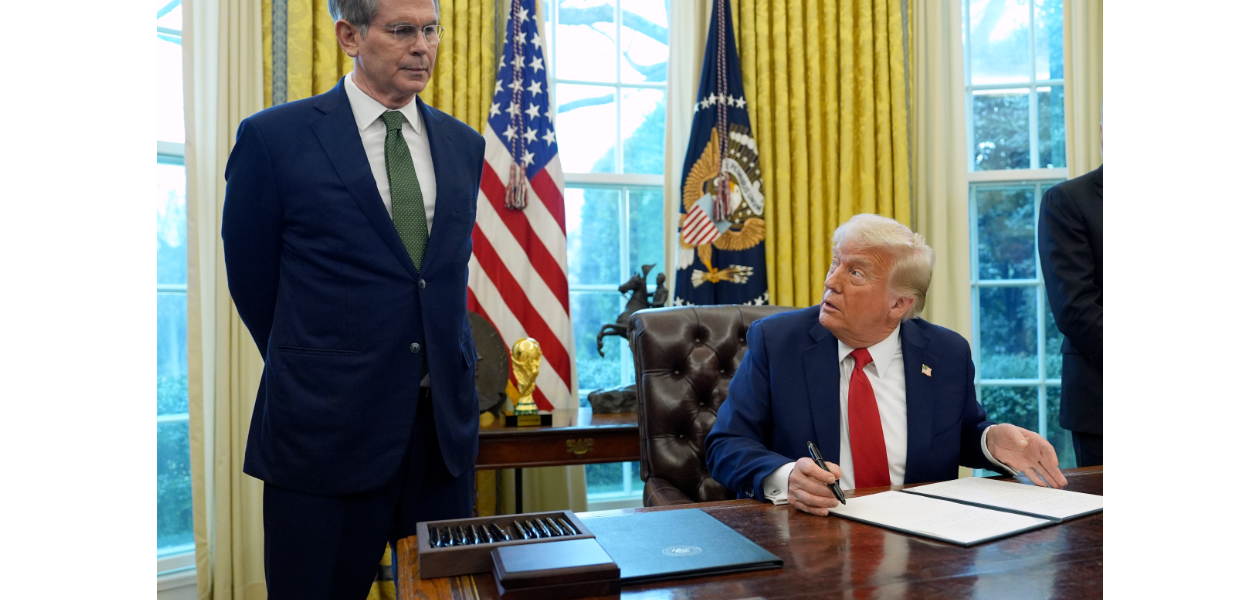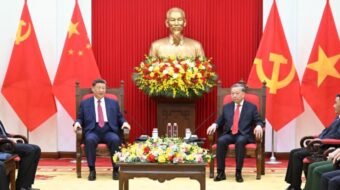
In the gold-encrusted Oval Office Wednesday afternoon, President Donald Trump stood basking in the glow of approving smiles from a group of aides and Wall Street financiers.
Why the smiles? Well, at that moment the New York Stock Exchange was exploding, with share prices that had been tanking for days suddenly soaring into the heavens, in some cases by 20% or more.
It was a stark reversal from the past few trading sessions, when his tariff war had erased nearly $6 trillion (that’s $6,000,000,000,000, with twelve zeros) in market value. Wednesday’s big beautiful bounce was the result of Trump declaring mid-day that he was pausing his “reciprocal tariff” economic war against most countries for 90 days.
Among the celebrants at the White House gathering was Charles Schwab (as Trump said, “It’s not just a company, it’s actually an individual”). In a short video clip posted to X by Trump staffer Margo Martin Wednesday, the president is seen pointing to Schwab and saying, “He made two-and-a-half billion today.” Gesturing toward another corporate executive off-camera, Trump says, “And he made $900 million. That’s not bad.”
These two billionaire buddies weren’t the only ones who profited from Trump’s climbdown in the trade war, though. Evidence is piling up that certain people knew the reversal was coming before it happened, and they used that knowledge to cash in.
The ultimate insider
The president himself sent public signals to his followers on Truth Social Wednesday morning. “THIS IS A GREAT TIME TO BUY!!! DJT,” he posted four hours before the pause announcement. DJT are his initials, but they also happen to be the stock code of his own company, Trump Media & Technology Group Corp. ($DJT), which went up 25% Wednesday.
Any honest court would take one look and conclude that what happened was market manipulation, with Trump’s social media post a confession of insider trading. It wasn’t just the $DJT self-enrichment post, though. The timing of other market moves suggests that a lot more information might have been given in whispers and secret phone calls behind the scenes.
There was a massive spike in NASDAQ call options (contracts giving the holder the option to buy shares at a given future price) in the last 20 minutes before Trump issued his 90-day reprieve. A select shadowy few investors scooped up discounts at the very moment when almost everyone else was still selling at bargain basement prices in an effort to cut their losses.
What followed was the biggest one-day NASDAQ gain in 80 years. Come Thursday, much of the stock surge had pulled back, but by then, the money was already in the bank for the lucky ones who knew what was coming.
Rep. Adam Schiff, D-Calif., asked after the damage was done, “Is Donald Trump’s inner circle illegally profiting off of these huge swings in the stock market by insider trading?” Referring to the call options spike, Rep. Alexandria Ocasio-Cortez, D-N.Y., posted on X: “Any member of Congress who purchased stocks in the last 48 hours should probably disclose that now…. We’re about to learn a few things. It’s time to ban insider trading in Congress.”

For Trump and his pals, it was a glorious way to end the day. But was it all part of a plan from the very beginning? A grand conspiracy to twist trade strategy, game the market, and make out like bandits?
No. More likely is that the market manipulation was an opportunistic response to what was actually a very bad day for Trump in his campaign to reshape world trade according to his whims. At best, the leaking of insider information fattened his own bank account and bought back the loyalty of some on Wall Street who’d soured on his tariff agenda.
Trump caved
What really happened Wednesday was that Trump caved.
Stock markets had been in freefall ever since his April 2 “Liberation Day.” Finance capitalists were almost unanimous in their anger. Other major countries were imposing their own retaliatory tariffs on the U.S. The storm of bad news meant several of the president’s advisors had spent days worrying that the financial panic could spiral out of control and spark a worldwide economic catastrophe.
But their boss urged them to “be cool,” assuring them, “I know what the hell I’m doing.” He’d insisted publicly just days earlier, “MY POLICIES WILL NEVER CHANGE.” The Wall Street Journal reported that Trump privately admitted his policies could cause a recession – which would mean mass layoffs – but he was okay with that as long as “it didn’t cause a depression.”
As it turned out, he didn’t know what he was doing, or at least he didn’t anticipate that there were other forces opposed to his policy who knew what they were doing. Treasury Secretary Scott Bessent spent Wednesday evening claiming that Trump’s tariff pause “was his strategy all along,” but the real story is that the president retreated.
The trigger was a selloff in the U.S. bond market, which was happening at the very moment Trump was on stage in D.C. claiming world leaders were begging for deals, “kissing my ass,” as he said.
U.S. Treasury Bonds are essentially IOUs, and the U.S. runs on debt, debt that is sold in regularly scheduled auctions. When times are good, the U.S. government can sell its debt with a low interest premium (yield). But when the world bond market – which is made up not just of foreign governments but a whole class of traders – loses confidence in the future of a country’s economy (or doesn’t like the policies its government is pursuing), they demand a higher yield, stop buying bonds altogether, and even dump the ones they already have.
On Tuesday, the yield rate on U.S. bonds soared. A massive sell-off of existing bonds combined with a lack of interest in the newest ones being issued put the squeeze on the Trump administration.
Analysts are still sorting out who the major sellers were, with big banks, hedge funds, foreign governments, and institutional investors in need of fast cash all likely playing a role. Many are examining the moves of the governments of Japan, the European Union, and China, which are the largest foreign holders of U.S. Treasurys.
Did they collectively sink the U.S. bond market in order to strike back at Trump? Possibly, but even if they didn’t, they now know they have the power to do so.

A full-on collapse in demand for U.S. bonds would cripple the government’s ability to raise money and freeze the financial system. Bank lending would seize up and economic activity could be paralyzed, as mortgage and loan interest rates typically follow bond yields.
Essentially, Trump was flirting with all-out economic disaster. When Bessent told him the blunt news Wednesday morning, the president finally blinked. That’s when he made the decision to pull back on the reciprocal tariffs, replacing it with a flat 10% rate on most of the world.
He ratcheted up his attack on China, though, resorting to what amounts to an economic embargo. He raised tariffs on that country to 145% (some calculations suggest they’re even higher), revealing that hobbling the People’s Republic was one of the most important goals all along.
He also maintained higher tariffs on Canada and Mexico, keeping up the economic attack which inaugurated this trade war.
Bond discipline
Smaller countries have long been subject to the discipline of bond markets. Progressive and left-wing governments, in particular, have often had their plans for health care, education, and housing spending scuttled by the maneuvering of bond traders and powerful state actors.
Controlling the demand for bonds has long been the finance capital’s ultimate veto power, the way it enforces “fiscal discipline” when governments do something that threatens its profits. This week, the Trump administration faced that same discipline, but it wasn’t because his government is pursuing a progressive agenda.
His campaign to reorient U.S. trade patterns is an effort to shore up U.S. hegemony in the world economy, block China’s development, and reconsolidate U.S. imperial power, but his method (madness?) does not enjoy unanimous support among the capitalist class.
The free market faction (along, probably, with governments targeted by his trade war, like Japan, EU, and China) struck back, leaving Trump reeling and his people spinning tales that everything was part of a plan, a means of forcing other countries to the negotiation table.
White House Press Secretary Karoline Leavitt said Wednesday’s events were an example of “the art of the deal.” But like Trump’s book by the same name, her words were a total work of fiction. Trump showed his hand, but as it turns out, he didn’t have the cards.
As with all news-analysis and op-ed articles published by People’s World, the views reflected here are those of the author.
We hope you appreciated this article. At People’s World, we believe news and information should be free and accessible to all, but we need your help. Our journalism is free of corporate influence and paywalls because we are totally reader-supported. Only you, our readers and supporters, make this possible. If you enjoy reading People’s World and the stories we bring you, please support our work by donating or becoming a monthly sustainer today. Thank you!











